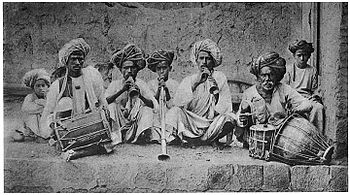The Mang, or Matang, community is an Indian caste mainly residing in the state of Maharashtra. Matang are known as Madiga "kommati" in Telangana, Andhra Pradesh and Karnataka.


The community was historically believed to be associated with village security and professions such as rope making, broom making, musicians, cattle castration, leather curing, midwifery, executioners, and funeral directors.[1] In modern day India, they are listed as a Scheduled Caste, Their origins lie in the Narmada Valley of India, and they were formerly classified as a criminal tribe under the Criminal Tribes Acts of the British Raj.[2]
Religion edit
The Mang practice Hinduism, Marathi and worship the deities Rama, Krishna Bhagavan, and Hanuman. As per 2011 census, around 25,000 Mang people notified religion as . Bhavani Janakamma is the caste deity of the Mang.In modern times, they are ardent followers of Chhatrapati Shivaji Maharaj, and many of them have converted to and practice Buddhism. Mang also worship spirits and village deities like Pochamma and Maisamma, who according to them are responsible for all the good and bad that befalls the village community. The Mang celebrate all major traditional festivals, as well as the annual Jatara festival for the deity Maisamma, which entails the sacrifice of sheep and goats and a feast of lamb and goat meat.[3]
Society and culture edit
Before the British era, Mang were one of the twelve hereditary village servants called Bara Balutedar. The Mang were the hereditary rope makers and village entertainers. For their services they received a share of the village produce. The caste was hindu and observed the Hindu rituals of Jawal (first hair cut), shendi, lagna, and funerary rites.[4] In the early 20th century, the Mang began to form caste associations to advocate their cause, such as the Mang Samaj (1932) and Mang Society (1923).[5][6]
References edit
- ^ Robert Vane Russell (1916). pt. II. Descriptive articles on the principal castes and tribes of the Central Provinces. Macmillan and Co., limited. pp. 188–. Retrieved 14 August 2012.
- ^ Bates, Crispin (1995). "Race, Caste and Tribe in Central India: the early origins of Indian anthropometry". In Robb, Peter (ed.). The Concept of Race in South Asia. Delhi: Oxford University Press. p. 227. ISBN 978-0-19-563767-0. Retrieved 1 December 2011.
- ^ http://lsi.gov.in:8081/jspui/bitstream/123456789/2806/1/41944_1961_ETH.pdf [bare URL PDF]
- ^ Krishnaji Nageshrao Chitnis (1994). Glimpses of Maratha Socio-economic History. Atlantic Publishers & Dist. pp. 125, 135. ISBN 978-81-7156-347-0.
- ^ Surajit Sinha (1 January 1993). Anthropology of Weaker Sections. Concept Publishing Company. pp. 330–. ISBN 978-81-7022-491-4. Retrieved 24 August 2013.
- ^ Prahlad Gangaram Jogdand (1991). Dalit movement in Maharashtra. Kanak Publications. Retrieved 24 August 2013.
Further reading edit
- Constable, Philip (May 2001). "The Marginalization of a Dalit Martial Race in Late Nineteenth- and Early Twentieth-Century Western India". The Journal of Asian Studies. 60 (2): 439–478. doi:10.2307/2659700. JSTOR 2659700. PMID 18268829. S2CID 40219522.